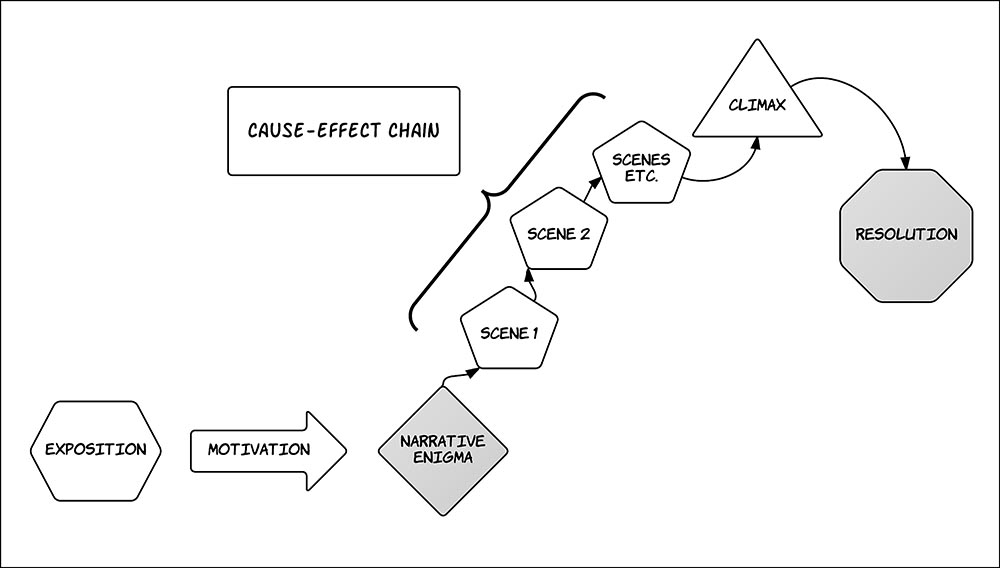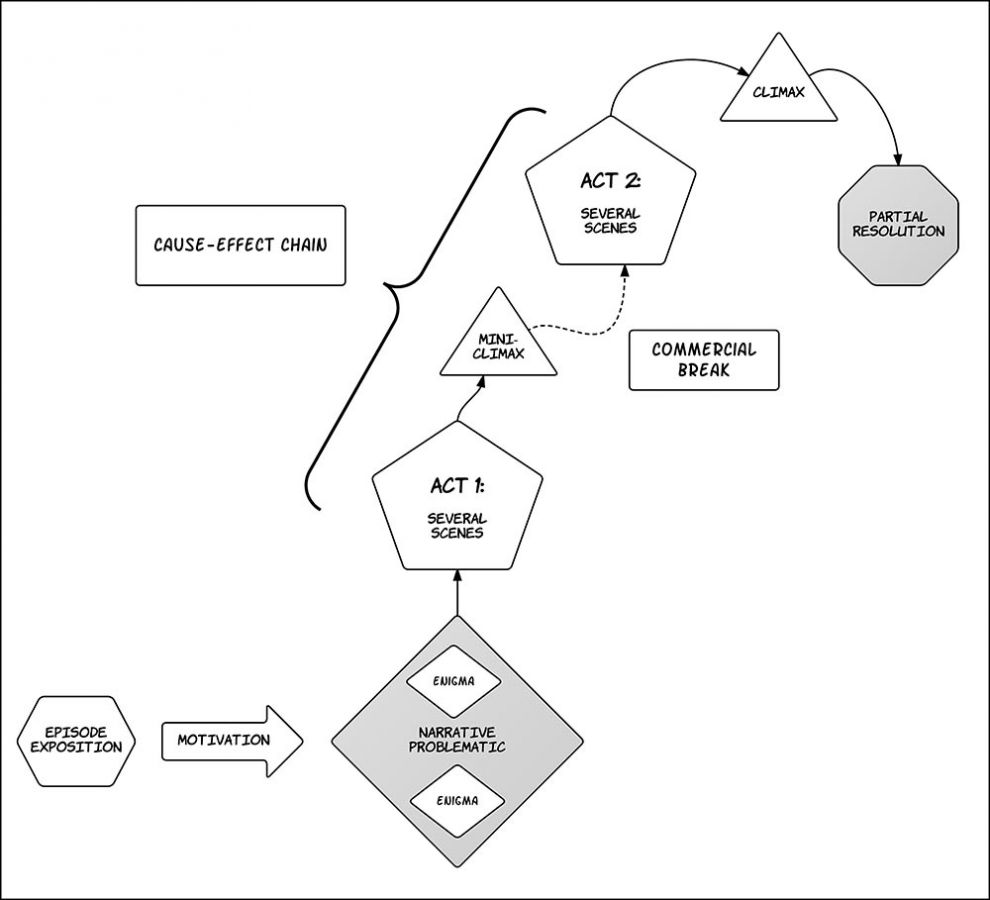|
|
| Line 1: |
Line 1: |
| − | [[Image:DoubleIndemnity.jpg|thumb|Fred MacMurray and Barbara Stanwyck in the film noir, ''[[wikipedia:Double Indemnity|Double Indemnity]]''.]]
| + | ==Classical Hollywood cinema== |
| − | '''TCF 440/540 Seminar in American Cinema''' is a discussion-oriented course taught by [[User:Jeremy Butler|Jeremy Butler]].
| + | <gallery mode="packed" heights=600px> |
| | + | File:Narrative Structure - Classical Film.jpeg|alt=Diagram of classical narrative structure.|''Television'' Figure 3.6 The rise and fall of the narrative action in classical film. |
| | + | </gallery> |
| | | | |
| − | == Course objectives ==
| + | Does ''Always Be My Maybe'' fit the classical implementation of: |
| | | | |
| − | The student will learn the three major critical methods applied to the American cinema: genre study, the auteur "theory," and the star "system." We will begin with the film noir, director Howard Hawks and actor Humphrey Bogart, and then, during the second half of the semester, turn our attention to the melodrama, director Douglas Sirk, and actress Lana Turner.
| + | #Single protagonist |
| | + | #Exposition |
| | + | #Motivation |
| | + | #Narrative enigma |
| | + | #Cause-effect chain |
| | + | #*''Story time'' versus ''screen time''--in terms of duration and order |
| | + | #Climax |
| | + | #Resolution |
| | | | |
| − | Our focus will shift back and forth from the primary texts (the films themselves) to the writings on them. The latter will eventually lead us into considerations of feminism, Marxism, structuralism and semiotics.
| + | ==The television series== |
| | | | |
| − | == Online study guides == | + | <gallery mode="packed" heights=600px> |
| − | ===Chronological order===
| + | File:Fig03-12 TV Series Narrative Structure - rendered.jpg|alt=Diagram of series-TV narrative structure.|''Television'' Figure 3.12 Linear-TV series' narrative structure must accommodate commercial interruptions and allow for a repeatable narrative problematic. |
| − | #Film Analysis: [[BordwellThompson/Narrative Form (Discussion)|Discussion]] of film form chapters, ''Film Art''
| + | </gallery> |
| − | #Classical Style I: [[TCF440540/Mise-en-scene (Discussion)|Discussion]] of mise-en-scene
| |
| − | #Classical Style II: [[TCF440540/Cinematography (Discussion)|Discussion]] of cinematography
| |
| − | #Editing: [[TCF440540/Editing (Discussion)|Discussion]] of editing
| |
| − | #Sound: [[TCF440540/Sound (Discussion)|Discussion]] of sound
| |
| − | #Concept of Genre: [[Concept of Genre (Lecture)| Lecture]] / [[Concept of Genre (Discussion) | Discussion]] of Kitses (6-27), Buscombe (33-45), Collins (157-163).
| |
| − | #Film Noir as Genre: [[Film Noir as Genre (Lecture)| Lecture]] / [[Film Noir as Genre (Discussion)|Discussion]] of Silver & Ursini (17-26, 37-52, 53-64, 65-76).
| |
| − | #Concept of Authorship: [[Concept of Authorship (Lecture)| Lecture]] / [[Concept of Authorship (Discussion)|Discussion]] of Caughie (9-16, 22-67).
| |
| − | #Howard Hawks as Auteur: [[Howard Hawks as Auteur (Lecture)| Lecture]] / [[Howard Hawks as Auteur (Discussion)|Discussion]] of Sarris (on Hawks, 52-56), Caughie (138-151), Hillier & Wollen (26-31, 32-34, 68-71, 83-86, 111-119).
| |
| − | #Noir & Sexuality: [[Noir & Sexuality (Lecture)| Lecture]] / [[Noir & Sexuality (Discussion) | Discussion]] of Place (47-68), Dyer (52-72).
| |
| − | #Concept of Star: [[Concept of Star (Lecture)| Lecture]] / [[Concept of Star (Discussion)|Discussion]] of Dyer (Stars, 106-50; recommended: 88-105).
| |
| − | #Humphrey Bogart as Star: [[Humphrey Bogart as Star (Lecture)| Lecture]] / [[Humphrey Bogart as Star (Discussion)|Discussion]] of Sklar (104-120, 165-176, 227-251).
| |
| − | #Domestic Melodrama as Genre: [[Domestic Melodrama as Genre (Lecture)| Lecture]] / [[Domestic Melodrama as Genre (Discussion)|Discussion]] of Haskell (153-188) -- in-class discussion preempted by midterm exam.
| |
| − | #Domestic Melodrama Since World War II: [[Domestic Melodrama Since World War II (Lecture)| Lecture]] / [[Domestic Melodrama Since World War II (Discussion)|Discussion]] of Gledhill (5-39), Elsaesser (43-69).
| |
| − | #Melodrama Variations: TV Soap Opera: [[Melodrama Variations: TV Soap Opera (Lecture)| Lecture]] / [[Melodrama Variations: TV Soap Opera (Discussion)|Discussion]] of Butler ("Apparatus," 53-70), Butler ("Actors," 75-91).
| |
| − | #Douglas Sirk as Auteur: [[Douglas Sirk as Auteur (Lecture)| Lecture]] / [[Douglas Sirk as Auteur (Discussion)| Discussion]] of Sarris (on Sirk, 109-110), Fischer (3-28, 268-272); recommended: Doherty ([http://www.tcf.ua.edu/EO/SirkEssay.htm online]).
| |
| − | #Lana Turner as Star: [[Lana Turner as Star (Lecture)| Lecture]] / [[Lana Turner as Star (Discussion)| Discussion]] of Dyer (30-52) [Also in Fischer (186-206)].
| |
| | | | |
| − | ===List of lecture notes===
| + | Break down the "The Vartabedian Conundrum" episode from ''The Big Bang Theory'' (December 8, 2008). Number each scene and provide a ''brief'' description of it. |
| − | [[:Category:TCF440/540 Lecture]]
| + | *How many scenes does it have? |
| | | | |
| − | ===List of discussion notes===
| + | Does the episode contain the conventional elements of a TV series? What are the key differences between its narrative structure and that of a classical film? |
| − | [[:Category:TCF440/540 Discussion]]
| + | #Multiple protagonists |
| | + | #Exposition |
| | + | #Motivation |
| | + | #Narrative problematic |
| | + | #Cause-effect chain |
| | + | #Climax |
| | + | #Resolution? |
| | | | |
| − | ==Study groups==
| + | [[Category:BUI301F2022]] |
| − | <table border="1" cellpadding="5">
| + | [[Category:BUI301F2022 Discussion]] |
| − | <tr>
| |
| − | <td valign="top">'''Group 1'''
| |
| − | <ul>
| |
| − | <li> Kenny Haggerty </li>
| |
| − | <li> Morgan Bruffy </li>
| |
| − | <li> Mallory Clark </li>
| |
| − | <li> Caitlyn Cofer </li>
| |
| − | <li> Abigail Connally </li>
| |
| − | <li> Brian DeLuca </li>
| |
| − | </ul>
| |
| − | <p>'''Group 3'''</p>
| |
| − | <ul>
| |
| − | <li> Mark Lent </li>
| |
| − | <li> Katherine Jackson </li>
| |
| − | <li> Clifton Lewis </li>
| |
| − | <li> Colter Longshore </li>
| |
| − | <li> Donald Miller </li>
| |
| − | </ul></td>
| |
| − | <td valign="top">'''Group 2'''
| |
| − | <ul>
| |
| − | <li> Bill Hartwig </li>
| |
| − | <li> Alex Jones </li>
| |
| − | <li> Lorrie Flowers </li>
| |
| − | <li> Stephanie Lichtenstein </li>
| |
| − | <li> Sophie Hall</li>
| |
| − | <li> Jake Hinson </li>
| |
| − | </ul>
| |
| − | <p>'''Group 4'''</p>
| |
| − | <ul>
| |
| − | <li> Alex Seiver </li>
| |
| − | <li> Nick Penfold </li>
| |
| − | <li> James Piazza </li>
| |
| − | <li> Alex Pointer </li>
| |
| − | <li> Shelby Utsey </li>
| |
| − | <li> James Ed West </li>
| |
| − | </ul></td>
| |
| − | </tr>
| |
| − | </table>
| |
| − | | |
| − | == Texts & resources ==
| |
| − | | |
| − | ===Books===
| |
| − | | |
| − | #David Bordwell and Kristin Thompson, ''Film Art: An Introduction''.
| |
| − | #John Caughie, ed., ''Theories of Authorship'' (Boston: Routledge & Kegan Paul, 1981).
| |
| − | #Richard Dyer, ''Stars'', Second Edition, Supplementary Chapter by Paul McDonald (London: British Film Institute, 1998).
| |
| − | #Recommended, not required: Lucy Fischer,ed., ''Imitation of Life: Douglas Sirk, Director'' (New Brunswick, NJ: Rutgers University Press, 1991).
| |
| − | | |
| − | ===Articles and book chapters===
| |
| − | #Jim Kitses, ''Horizons West'' (Bloomington: Indiana University Press, 1969) 6-27.
| |
| − | #Edward Buscombe, "The Idea of Genre in the American Cinema," ''Screen'', 11.2 (1970): 33-45.
| |
| − | #Richard Collins, "Genre: A Reply to Ed Buscombe," ''Movies and Methods'', ed. Bill Nichols (Berkeley: University of California Press, 1976) 157-163.
| |
| − | #Alain Silver and James Ursini, eds., ''Film Noir Reader'' (New York: Limelight, 1996).
| |
| − | #Andrew Sarris, ''The American Cinema: Directors and Directions 1929-1968'' (New York: Simon & Schuster, 1973) 52-56, 109-110.
| |
| − | #Jim Hillier and Peter Wollen, eds., ''Howard Hawks American Artist'' (London: British Film Institute, 1996).
| |
| − | #Janey Place, "Women in Film Noir," ''Women in Film Noir'', ed. E. Ann Kaplan (London: British Film Institute, 1998) 47-68.
| |
| − | #Richard Dyer, "Homosexuality and Film Noir," ''The Matter of Images: Essays on Representations'' (London and New York: Routledge, 1993) 52-72.
| |
| − | #Robert Sklar, ''City Boys: Cagney, Bogart, Garfield'' (Princeton, NJ: Princeton University Press, 1992).
| |
| − | #Molly Haskell, "The Woman's Film," in ''From Reverence to Rape: The Treatment of Women in the Movies'' (New York: Penguin, 1974) 153-188.
| |
| − | #Christine Gledhill, "The Melodrama Field: An Investigation," ''Home is Where the Heart Is: Studies in Melodrama and Woman's Film'', ed. Christine Gledhill (London: British Film Institute, 1987) 5-39.
| |
| − | #Thomas Elsaesser, "Tales of Sound and Fury: Observations on the Family Melodrama," ''Home is Where the Heart Is'', 43-69.
| |
| − | #Jeremy G. Butler, "Notes on the Soap Opera Apparatus: Televisual Style and ''As the World Turns''," ''Cinema Journal'', 25.3 (1986): 53-70.
| |
| − | #Jeremy G. Butler, "'I'm Not a Doctor, But I Play One on TV': Characters, Actors, and Acting in Television Soap Opera," ''Cinema Journal'' 30.4 (1991): 75-91.
| |
| − | #Lucy Fischer, "Three-Way Mirror: Imitation of Life," ''Imitation of Life: Douglas Sirk'', Director ed. Lucy Fischer (New Brunswick, NJ: Rutgers University Press) 3-28.
| |
| − | #Paul Willemen, "Distanciation and Douglas Sirk," ''Imitation of Life: Douglas Sirk, Director'', 268-272.
| |
| − | #Recommended, not required: Thomas Doherty, "Douglas Sirk: Magnificent Obsession," ''The Chronicle Review'', 49, no. 12 (November 15, 2002), p. B16. Available online.
| |
| − | #Richard Dyer, "Four Films of Lana Turner," ''Movie'' 25: 30-52.
| |
| − | | |
| − | [[Category:TCF440-540]] | |
| − | [[Category:TCF Classes]] | |

